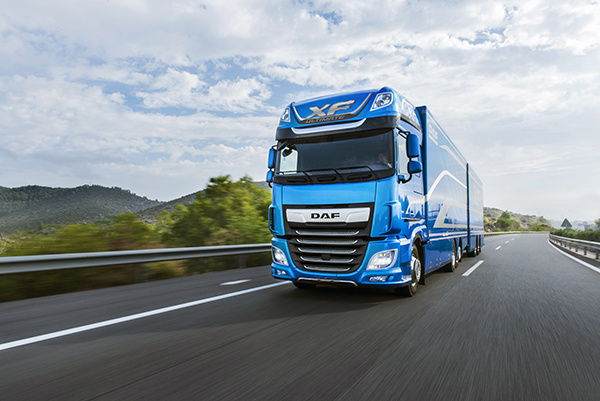DAF leads the way to larger, more aerodynamic cabs
Paccar’s DAF subsidiary will be the first manufacturer to take advantage in changes to EU dimension laws when it launches its replacement for its long-running XF flagship truck this month.
Sources close to the factory have suggested that we may see it in the UK as soon as the ITT Hub on 30 June, following a ‘virtual’ online launch scheduled for 9 June.
Prototypes have been spotted wearing various degrees of disguise kit, and DAF has also launched a teaser campaign giving glimpses of the new truck on social media. With production at all European truck factories struggling to keep up with current demand, actual customer deliveries of the new vehicle are unlikely before next year.
The XF has the longest-running truck cab design in the European market: with the basic shell first appearing in the late 1980s as the DAF 95. The introduction of the high-roof Super Space Cab followed in 1995, and various powertrain, styling, and interior changes came to produce the XF and XF105 variants over the years.
DAF, however, always argued that there was no point in changing the basic cab shell, as it was a shape that fitted almost completely into the virtual ‘box’ created by European legislation on truck dimensions.
“Any new design will give us exactly the same shape, so why?” was always the argument when the question was asked about its replacement.
The EU extended the dimensional ‘envelope’ for truck cabs in 2020, and it was something of a surprise that new designs from MAN and Iveco launched at the time did not take advantage of this.
Iep van der Meer of the Dutch language website bigtruck.nl spotted what appeared to be a pre-production version of the new DAF in medium-height Space Cab form, and was able to measure some key dimensions. The 4×2 chassis has an unusually long wheelbase of 4 metres, while the cab itself is 2.6 metres from the bumper to the rear cab wall: 35 cm longer than the current model. The sleeper compartment (measured from the rear door pillar to the back of the cab wall) is 1.09 metres: 0.14 metres longer than today’s trucks.
The front overhang has been extended to 1.5 metres from 1.35 metres, and the front end of the truck is less blunt than its predecessor.
Iep van der Meer also noticed a blanked-off kerb-view window in the nearside door. That particular truck had conventional mirrors, but others have been seen with a Mercedes-style rear-vision camera system.
The front bumper no longer one-piece, meaning that minor damage need not entail its entire replacement, and van der Meer also reports that there is a smooth under-tray to manage air-flow beneath the vehicle.
DAF’s current engine ranges already meet the upcoming Euro VI E emissions limits, but there is a suggestion that a further engine option of a 16-litre Cummins may be on offer taking DAF into the 600 hp bracket. The top power option on the original 95 was also supplied by Cummins, and Cummins supplies engines for DAFs LF lightweight truck, which are labelled as Paccar products.
A question remains as to whether a narrower version of the new cab will replace the cab on the current mid-range CF models: DAF is unusual in having three unique cab designs in its range from 7.5 to 44-tonnes: most other manufacturers have a far greater degree of commonality between their regional and long-haul designs.
The EU’s dimension changes have been driven by a realisation that safety for vulnerable road users, and aerodynamic fuel efficiency, could both be improved by allowing truck design to grow outside the ‘box’ imposed by constraints on cab length.
The new truck launch is expected on 9 June at:












